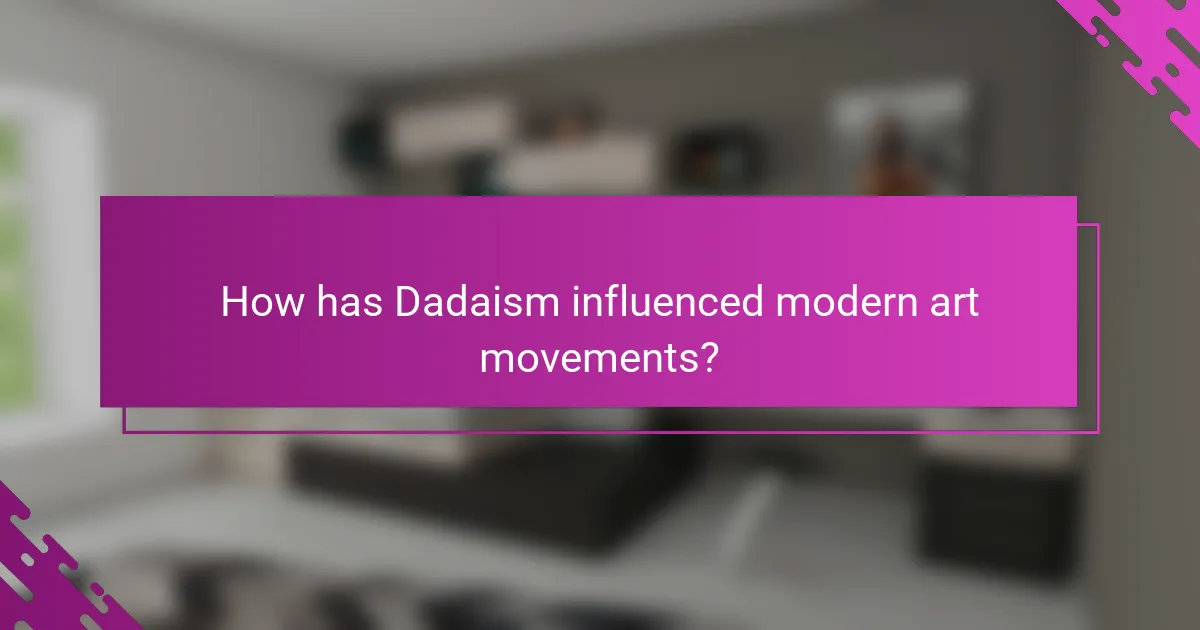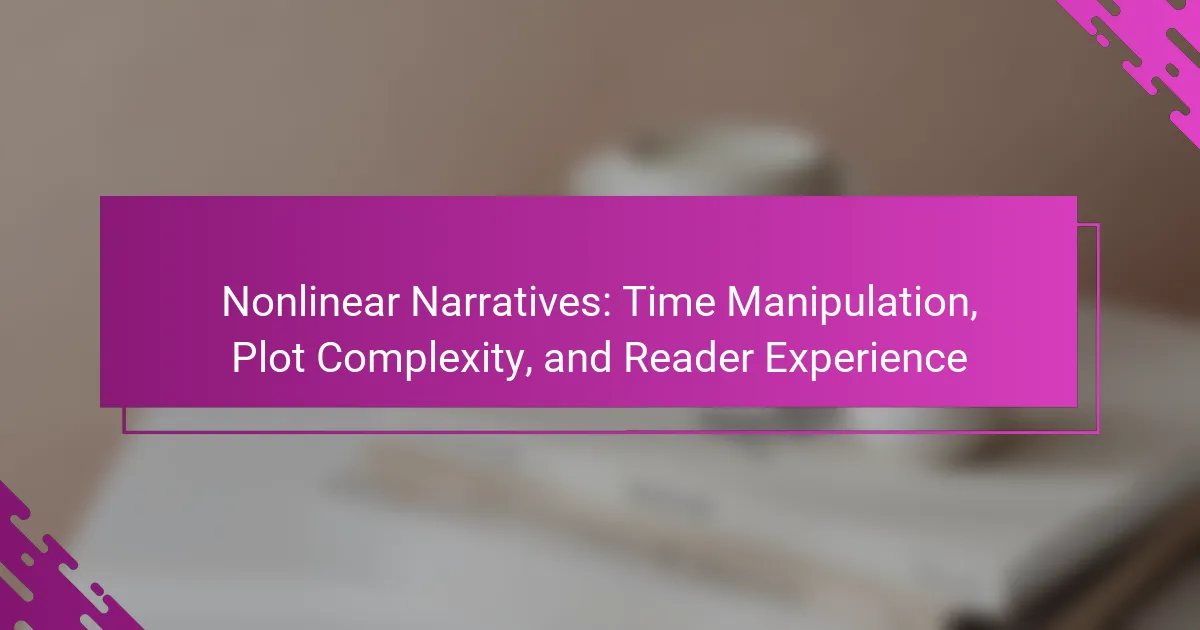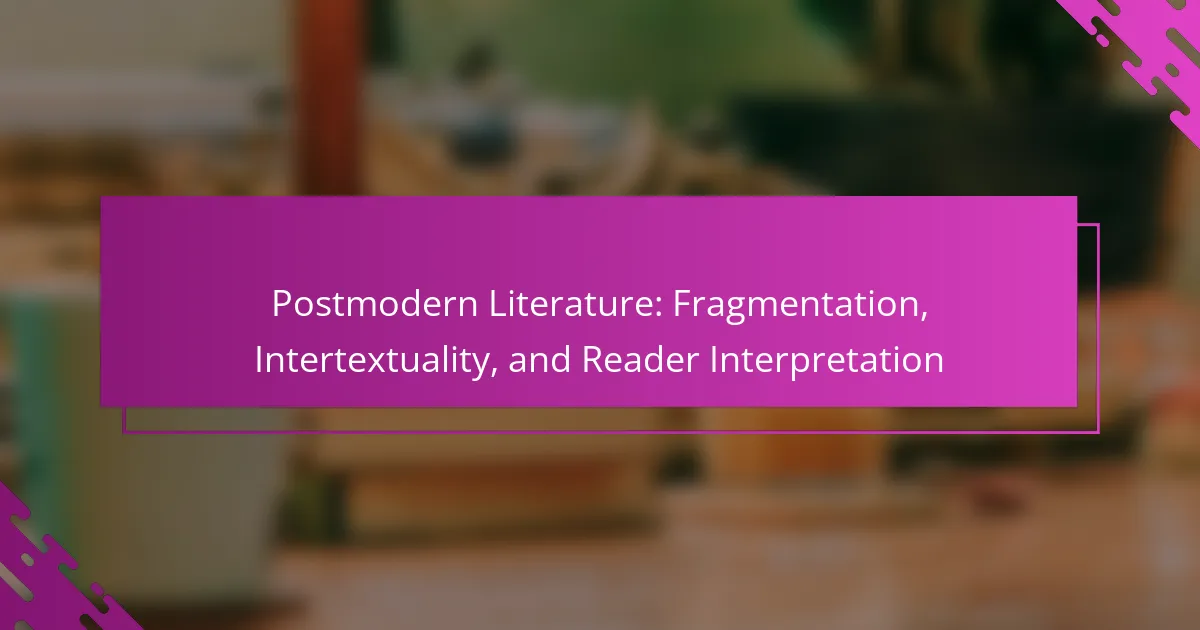Dadaism revolutionizes artistic expression by challenging conventional norms and embracing absurdity. This article explores its historical context, key figures like Marcel Duchamp, and its influence on modern art movements. It also examines the diverse cultural perceptions of Dadaism and its lasting impact on society.

What are the key principles of Dadaism?
Dadaism challenges conventional artistic norms through absurdity and anti-art sentiments. Key principles include spontaneity, rejection of reason, and embracing chaos. Dadaists aimed to provoke thought and question societal values, often utilizing collage, readymades, and performance art. Their legacy influences contemporary art movements, emphasizing creativity beyond traditional boundaries.
How did Dadaism challenge traditional artistic norms?
Dadaism fundamentally challenged traditional artistic norms by embracing absurdity and anti-art sentiments. It rejected established aesthetics and conventions, promoting spontaneity and irrationality. Dada artists used unconventional materials and techniques, blurring the lines between art and everyday objects. This movement questioned the role of the artist and the definition of art itself, influencing modern art forms like conceptual art and performance art.
Why is anti-art a fundamental aspect of Dadaism?
Anti-art is fundamental to Dadaism as it challenges traditional artistic values and conventions. Dadaism emerged as a reaction to World War I, emphasizing absurdity and spontaneity. This movement sought to disrupt established norms, promoting the idea that art could be anything, including anti-art. Dadaists believed that by rejecting conventional aesthetics, they could provoke thought and question societal values. The unique attribute of Dadaism lies in its embrace of chaos and irrationality, making anti-art a powerful tool for expressing dissent and promoting freedom of expression.

How did historical events shape the emergence of Dadaism?
Historical events significantly influenced the emergence of Dadaism as a reaction to the chaos of World War I. Artists sought to challenge traditional aesthetics and societal norms, reflecting the disillusionment of the era. The movement emerged in Zurich around 1916, where artists gathered to express their outrage against war and nationalism. Dadaism’s unique attributes included its embrace of absurdity and spontaneity, allowing artists to break free from conventional artistic constraints. As a result, Dadaism laid the groundwork for modern art movements, promoting the idea that art could serve as a form of protest and social commentary.
What role did World War I play in the development of Dadaism?
World War I significantly influenced the development of Dadaism by fostering a reaction against traditional artistic norms. The war’s brutality led artists to question established values and conventions. Dadaism emerged as an anti-art movement, embracing chaos and absurdity to critique societal norms. Artists like Tristan Tzara and Marcel Duchamp used unconventional methods to express their disillusionment with the war and its aftermath. This movement reflected a unique attribute of creativity born from conflict, emphasizing spontaneity and irrationality in art. Dadaism’s legacy continues to inspire modern artistic expressions that challenge conventions.
Which cities became significant centers for Dadaist activity?
Significant centers for Dadaist activity included Zurich, Berlin, New York, and Paris. These cities fostered vibrant artistic communities that embraced Dadaism’s anti-establishment ethos. Zurich, as the birthplace, hosted key figures like Tristan Tzara. Berlin became a hub for politically charged Dada works. New York and Paris contributed to the movement’s evolution and global influence, showcasing diverse interpretations and adaptations.

What are the prominent figures associated with Dadaism?
Prominent figures associated with Dadaism include Marcel Duchamp, Tristan Tzara, Hugo Ball, and Hannah Höch. These artists challenged traditional artistic norms and embraced absurdity, creating works that reflected the chaos of their time. Duchamp’s “Fountain” is a notable example, exemplifying Dada’s unique approach to art. Tzara and Ball were instrumental in defining Dada’s philosophy and organizing early performances. Höch’s pioneering collage techniques contributed significantly to the movement’s visual language.
How did Marcel Duchamp influence Dadaist philosophy?
Marcel Duchamp significantly influenced Dadaist philosophy by challenging traditional artistic norms. His use of ready-made objects questioned the very definition of art, promoting the idea that art could be conceptual rather than purely aesthetic. Duchamp’s work encouraged Dadaists to embrace absurdity and anti-art sentiments, shaping their collective identity. His iconic piece, “Fountain,” exemplified this shift, demonstrating that context and intention could redefine an object’s artistic value. This radical approach inspired future avant-garde movements, emphasizing the importance of ideas over craftsmanship.
Which other artists are considered pivotal in the Dada movement?
Key artists pivotal in the Dada movement include Marcel Duchamp, Tristan Tzara, and Hannah Höch. Duchamp challenged traditional art with his readymades, while Tzara was instrumental in the movement’s philosophy. Höch contributed significantly through her photomontages, highlighting gender and societal issues. Other notable figures include Kurt Schwitters and Jean Arp, who expanded Dadaism’s reach into various mediums.

What mediums and techniques were commonly used in Dada art?
Dada artists commonly employed mediums such as collage, photomontage, and ready-mades. They utilized techniques that included performance art, assemblage, and spontaneous creation. These methods emphasized anti-art sentiments and challenged traditional artistic norms. Dadaism’s experimental nature fostered a diverse range of artistic expressions.
How did collage and assemblage redefine artistic expression in Dadaism?
Collage and assemblage redefined artistic expression in Dadaism by challenging traditional art forms. These techniques utilized everyday materials, promoting anti-art sentiments and emphasizing randomness. Artists like Hannah Höch and Kurt Schwitters created works that questioned societal norms and conventions. This innovative approach allowed for a unique exploration of identity, culture, and the absurd, making Dadaism a pivotal movement in modern art.
Which performance art elements were integral to Dadaist events?
Dadaist events integrated elements like spontaneity, absurdity, and audience participation. These characteristics challenged traditional art forms and emphasized anti-art sentiments. Performance art in Dadaism often included improvisation, theatricality, and the use of unconventional materials. The chaotic nature of these performances reflected the movement’s critique of societal norms and conventions.

How has Dadaism influenced modern art movements?
Dadaism has profoundly influenced modern art movements by promoting anti-establishment ideals and embracing absurdity. Its emphasis on spontaneity and irrationality paved the way for movements like Surrealism and Abstract Expressionism. Dada artists, such as Marcel Duchamp, challenged traditional notions of art, leading to new forms of expression that prioritize the artist’s intent over technical skill. This legacy of questioning conventions continues to resonate in contemporary art, where the boundaries of creativity are constantly redefined.
What connections exist between Dadaism and Surrealism?
Dadaism and Surrealism share a connection through their rejection of traditional artistic norms and embrace of irrationality. Both movements emerged in the early 20th century, with Dadaism reacting against World War I and Surrealism seeking to explore the unconscious mind. Dada artists often used absurdity and chance, while Surrealists aimed to unlock creativity through dreams and fantasies. This interplay of spontaneity and subconscious exploration highlights their intertwined evolution in challenging societal conventions.
Which contemporary artists draw inspiration from Dadaist principles?
Contemporary artists like Damien Hirst, Marcel Duchamp, and Yoko Ono draw inspiration from Dadaist principles. They incorporate absurdity, chance, and anti-art sentiments into their work, reflecting Dada’s influence on modern art. Artists such as Banksy and Tracey Emin also utilize Dadaist techniques, challenging societal norms and conventions through provocative installations and street art. This connection to Dadaism highlights the movement’s lasting impact on artistic expression today.

What are the cultural perceptions of Dadaism in different regions?
Cultural perceptions of Dadaism vary significantly across regions. In Europe, Dadaism is often seen as a radical challenge to traditional art forms, reflecting the chaos of World War I. In North America, it is viewed as a precursor to modern art movements, influencing abstract expressionism. In Asia, Dadaism’s impact is less pronounced, but it inspires contemporary artists exploring anti-establishment themes. Latin America embraces Dadaism for its avant-garde spirit, intertwining it with local cultural narratives. Overall, Dadaism’s legacy continues to provoke discussions on art’s role in society.
How is Dadaism interpreted in European art circles today?
Dadaism is viewed in European art circles today as a radical critique of traditional aesthetics and societal norms. Contemporary artists draw inspiration from Dada’s anti-art stance, embracing absurdity and spontaneity. Exhibitions often highlight its influence on modern movements like conceptual art and performance art. Dadaism’s legacy persists through its challenge to the status quo, encouraging artists to question conventions and explore new mediums.
What significance does Dadaism hold in the context of Latin American art?
Dadaism significantly influenced Latin American art by challenging conventional aesthetics and embracing absurdity. It inspired artists to explore identity, politics, and social issues through unconventional mediums. Dadaism’s emphasis on anti-art paved the way for movements like Surrealism, which further shaped Latin American artistic expression. Its legacy persists in contemporary art, where artists continue to question norms and provoke thought.

What are the lasting impacts of Dadaism on society and culture?
Dadaism has profoundly influenced society and culture by challenging traditional artistic norms and promoting anti-establishment sentiments. Its lasting impacts include the rise of conceptual art, the questioning of societal values, and the embrace of absurdity in creative expression. Dadaism’s unique attribute lies in its radical rejection of logic, which inspired movements like Surrealism and Fluxus, reshaping modern art. As a result, contemporary artists continue to draw from Dadaist principles, fostering innovation and diversity in artistic practices.
How does Dadaism continue to inspire social and political critiques?
Dadaism continues to inspire social and political critiques by challenging established norms and promoting anti-art sentiments. Its emphasis on absurdity and spontaneity encourages contemporary artists to question authority and societal conventions. Modern adaptations of Dadaism often incorporate multimedia forms, allowing for broader expressions of dissent. This ongoing relevance highlights Dadaism’s unique attribute of fostering radical thought through artistic chaos.
Why is Dadaism relevant in discussions about contemporary art and activism?
Dadaism remains relevant in contemporary art and activism due to its anti-establishment ethos and emphasis on absurdity. This movement challenges traditional artistic norms, encouraging artists to express dissent and provoke thought. Dadaism’s legacy inspires modern creators to question societal values and explore unconventional forms of expression. Its unique attributes, such as the use of chance and spontaneity, resonate in today’s art and activism, fostering dialogue on issues like war, consumerism, and identity. As a result, Dadaism serves as a powerful tool for cultural critique and social change.
What best practices can artists adopt from Dadaist philosophy?
Artists can adopt several best practices from Dadaist philosophy to enhance their creative expression. Embrace spontaneity and randomness, allowing for unexpected outcomes in the creative process. Challenge conventional aesthetics by incorporating absurdity and irony into artworks. Engage in collaboration and collective action, fostering a community-oriented approach to art-making. Utilize mixed media and unconventional materials, promoting experimentation and innovation. Lastly, question societal norms and values through art, encouraging critical dialogue and reflection.



